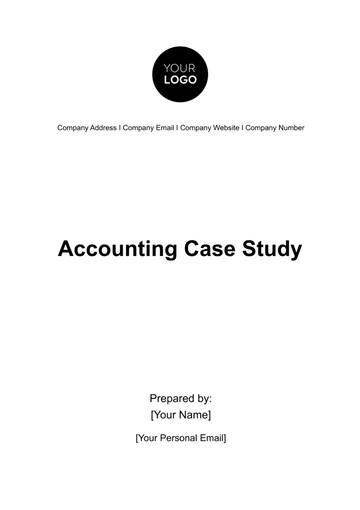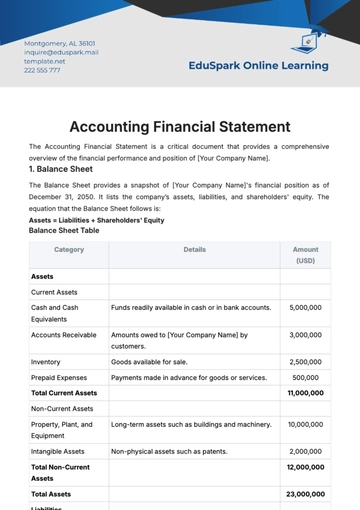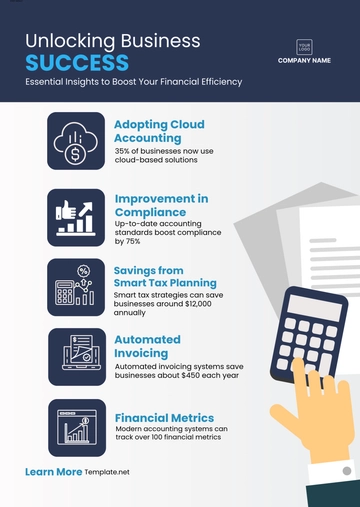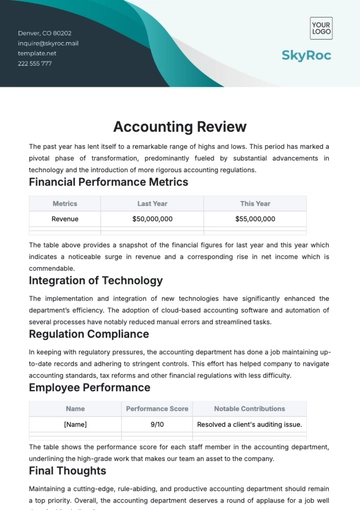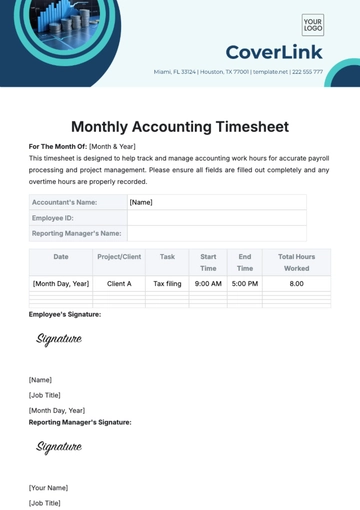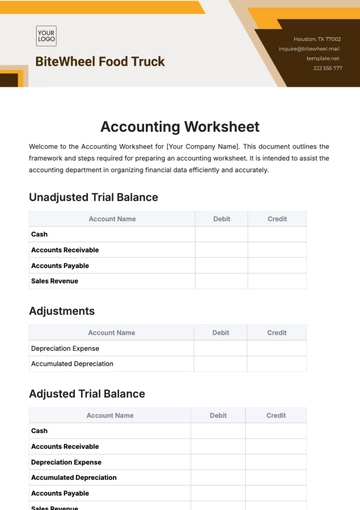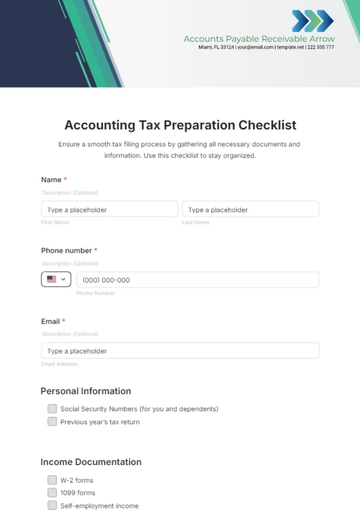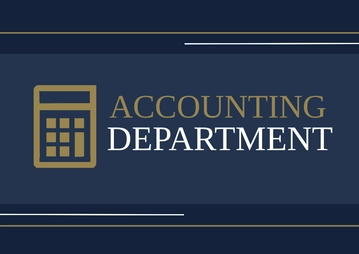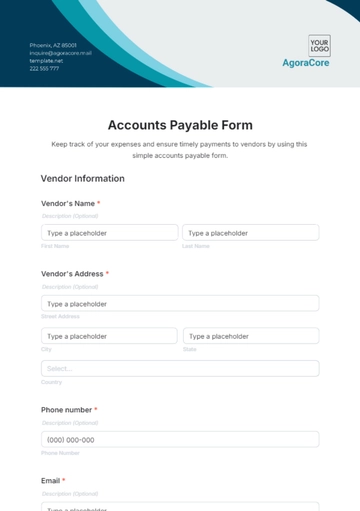Free Accounting Sustainability Study

I. Executive Summary
A. Brief Overview
[Your Company Name], a global leader in sustainable business practices, has prioritized environmental, social, and governance (ESG) considerations to create long-term value for stakeholders. This report provides a concise overview of our commitment to sustainability and the significant strides made in reducing our environmental footprint, fostering social responsibility, and ensuring robust governance.
B. Key Achievements and Milestones
In the fiscal year [Year], [Your Company Name] achieved notable milestones. Our comprehensive sustainability initiatives resulted in a [00]% reduction in carbon emissions, underscoring our commitment to combat climate change. Additionally, our diversity and inclusion program led to a [00]% increase in underrepresented workforce members. Our engagement with local communities through philanthropic efforts contributed $[000,000] to impactful community development projects, marking a significant milestone in our corporate social responsibility journey.
C. Summary of Sustainability Performance
The holistic approach to sustainability is reflected in key performance metrics. [Your Company Name] successfully reduced carbon emissions, increased workforce diversity, and contributed substantively to community development projects. These achievements affirm our dedication to balancing financial success with responsible and ethical business practices.
II. Introduction
A. Background and Purpose
[Your Company Name], founded on principles of innovation and responsibility, recognizes that sustainability is integral to long-term business success. This report aims to provide stakeholders with a detailed insight into our sustainability practices, focusing on the positive impact we aim to achieve across environmental, social, and governance dimensions. By adhering to Global Reporting Initiative (GRI) standards, we ensure transparency and comparability with industry benchmarks.
B. Scope of the Accounting Sustainability Study
This study encompasses all facets of [Your Company Name]'s global operations during the fiscal year [Year]. From manufacturing and distribution to corporate offices, our commitment to sustainability is reflected in the entirety of our supply chain and corporate activities.
C. Relevant Reporting Standards and Frameworks
To ensure the highest standards of reporting, [Your Company Name] aligns its sustainability disclosures with the Global Reporting Initiative (GRI) Standards. This framework provides a robust structure for reporting on economic, environmental, and social performance metrics, enhancing the reliability and credibility of our disclosures.
III. Governance
A. Governance Structure
The Board of Directors at [Your Company Name] actively oversees sustainability initiatives through regular meetings and comprehensive committee reports. Board members bring diverse expertise to the table, ensuring that sustainability considerations are seamlessly integrated into strategic decision-making processes.
B. Ethical Practices
Our commitment to ethical practices is exemplified through our comprehensive Code of Conduct. All employees undergo annual ethics training, reinforcing our dedication to fostering a culture of integrity and ethical decision-making.
C. Transparency and Accountability
[Your Company Name] prioritizes transparency and accountability in all aspects of its operations. Our disclosure practices extend beyond financial reporting, encompassing non-financial indicators and ESG factors. To further strengthen our commitment to responsible business practices, we have implemented a robust risk management framework that includes ESG risk assessments.
IV. Environmental Sustainability
A. Energy Consumption
[Your Company Name]'s commitment to sustainable energy is evident in its energy consumption practices. A detailed breakdown reveals that [00]% of our energy is sourced from renewable sources, while natural gas and grid electricity contribute [00]% and [00]%, respectively. These figures underscore our diversified and sustainable energy portfolio.
B. Carbon Emissions
The meticulous examination of our carbon emissions sources indicates that [00]% is attributed to manufacturing, [00]% to transportation, and 10% to facilities. [Your Company Name] has adopted targeted strategies, such as transitioning to electric vehicles and investing in renewable energy sources, resulting in a commendable [00]% reduction in overall carbon emissions.
C. Resource Usage
[Your Company Name] has implemented efficient measures to manage water consumption, resulting in a [00]% reduction. Additionally, sustainable sourcing practices have led to an [00]% decrease in overall raw material consumption. Our commitment to resource conservation is further highlighted by waste management initiatives, including a [00]% reduction in solid waste generation through recycling programs.
D. Waste Management
Detailed data on waste management practices at [Your Company Name] reveals a comprehensive approach to waste reduction. Solid waste generation has been reduced by [00]%, hazardous waste remains at minimal levels ([0] tons), and recycling rates have increased by [00]%. These achievements align with our commitment to sustainable and responsible waste management practices.
V. Social Responsibility
A. Employee Well-Being
[Your Company Name] prioritizes employee well-being through extensive health and safety programs. With [000]% participation in safety training and an [00]% engagement rate in employee assistance programs, we ensure a safe and supportive work environment. This commitment has resulted in a [00]% improvement in employee satisfaction, underscoring our dedication to fostering a positive workplace culture.
B. Diversity and Inclusion
Our diversity initiatives, including targeted recruitment strategies, have led to a commendable [00]% increase in workforce diversity. Simultaneously, inclusion programs, such as mentorship initiatives, contribute to creating an inclusive work environment where employees of all backgrounds can thrive.
C. Community Engagement
[Your Company Name]'s commitment to community development is exemplified through our philanthropic efforts. With a contribution of $[000,000] to community development projects, impacting over [00,000] lives, we actively engage with and support the communities in which we operate. These initiatives align with our values of corporate philanthropy and social responsibility.
VI. Economic Impact
A. Economic Contributions
[Your Company Name]'s economic contributions underscore our commitment to fostering economic development. With $[00 billion] in revenue and a [00]% increase in net profit compared to the previous year, we continue to generate substantial economic value. Moreover, our global operations employ [0,000] individuals, contributing to employment generation and economic growth in diverse regions.
B. Supply Chain Impact
Our commitment to responsible sourcing practices is evident in our collaboration with suppliers. [Your Company Name] actively engages with suppliers to implement sustainability practices, ensuring responsible sourcing. This collaborative approach has led to a commendable [00]% increase in the number of sustainable suppliers in our supply chain.
VII. Stakeholder Engagement
Metric | Measurement | Reporting Frequency | Example Result |
|---|---|---|---|
Employee Satisfaction | Annual employee satisfaction survey scores | Annually | Average satisfaction score of 4.5 out of 5 |
Customer Feedback | Number of customer feedback submissions | Monthly | [000] customer feedback submissions received |
Investor Engagement | Number of investor meetings or calls | Quarterly | [00] investor meetings held |
Community Outreach | Number of community events participated in | Semi-annually | [00] community events participated in |
Supplier Collaboration | Percentage of suppliers engaged in sustainability programs | Annually | [00]% of suppliers engaged in sustainability programs |
A. Identification of Key Stakeholders
[Your Company Name] actively engages with a diverse group of stakeholders, including customers, employees, investors, regulators, and local communities. Through regular stakeholder engagement initiatives, we seek to understand their expectations and incorporate their insights into our sustainability strategies.
B. Methods of Engagement
Our commitment to stakeholder engagement is manifested through surveys and feedback mechanisms, providing stakeholders with opportunities to share their perspectives. Additionally, regular consultations with key stakeholders ensure ongoing dialogue and the incorporation of diverse viewpoints in our sustainability initiatives.
VIII. Compliance and Reporting
A. Compliance with Sustainability Standards
[Your Company Name] maintains a steadfast commitment to compliance with sustainability reporting standards. Our sustainability report adheres to the Global Reporting Initiative (GRI) Standards and other relevant frameworks, ensuring that our disclosures meet the highest industry benchmarks.
B. External Assurance Process
To enhance the credibility and reliability of our sustainability disclosures, [Your Company Name] engages external auditors. These auditors provide independent assurance on the accuracy and completeness of our sustainability disclosures, reinforcing our commitment to transparency and accountability.
C. Reporting Timeline and Frequency
[Your Company Name] publishes its sustainability report annually, adhering to a predetermined reporting timeline. This regular reporting frequency ensures timely and transparent communication of our sustainability performance to stakeholders.
IX. Future Goals and Targets
A. Sustainability Objectives
Looking ahead, [Your Company Name] has set ambitious sustainability objectives. We aim to achieve net-zero carbon emissions by [Year] and increase diversity representation to [00]% within the next three years. These objectives reflect our commitment to continuous improvement and addressing the challenges posed by climate change and workforce diversity.
B. Continuous Improvement Initiatives
To achieve our sustainability objectives, [Your Company Name] will invest in renewable energy sources to achieve [00]% renewable energy usage. Additionally, we will enhance social impact measurement and reporting methodologies, ensuring a comprehensive understanding of our societal contributions and areas for improvement.
XI. Conclusion
A. Summary of Key Findings
In conclusion, [Your Company Name]'s Accounting Sustainability Study not only reflects our past achievements but also outlines a bold path forward. Our future goals and continuous improvement initiatives demonstrate our proactive stance in addressing global challenges. By setting ambitious sustainability objectives and embracing innovative practices, we aim to be at the forefront of sustainable business practices and corporate responsibility.
B. Acknowledgments and Appreciation
We extend our deepest gratitude to our employees, stakeholders, and partners who have played a pivotal role in our sustainability journey. The collective efforts of our global community propel us towards a more sustainable, responsible, and resilient future. Together, we will continue to push boundaries, driving positive change for the benefit of the planet and future generations.
- 100% Customizable, free editor
- Access 1 Million+ Templates, photo’s & graphics
- Download or share as a template
- Click and replace photos, graphics, text, backgrounds
- Resize, crop, AI write & more
- Access advanced editor
Explore sustainability effortlessly with the Accounting Sustainability Study Template from Template.net. This fully editable and customizable template, available on our platform, empowers you to showcase your organization's commitment to ESG practices. Seamlessly adapt content with our intuitive AI Editor Tool, ensuring a polished and comprehensive report. Elevate your sustainability narrative with ease.









